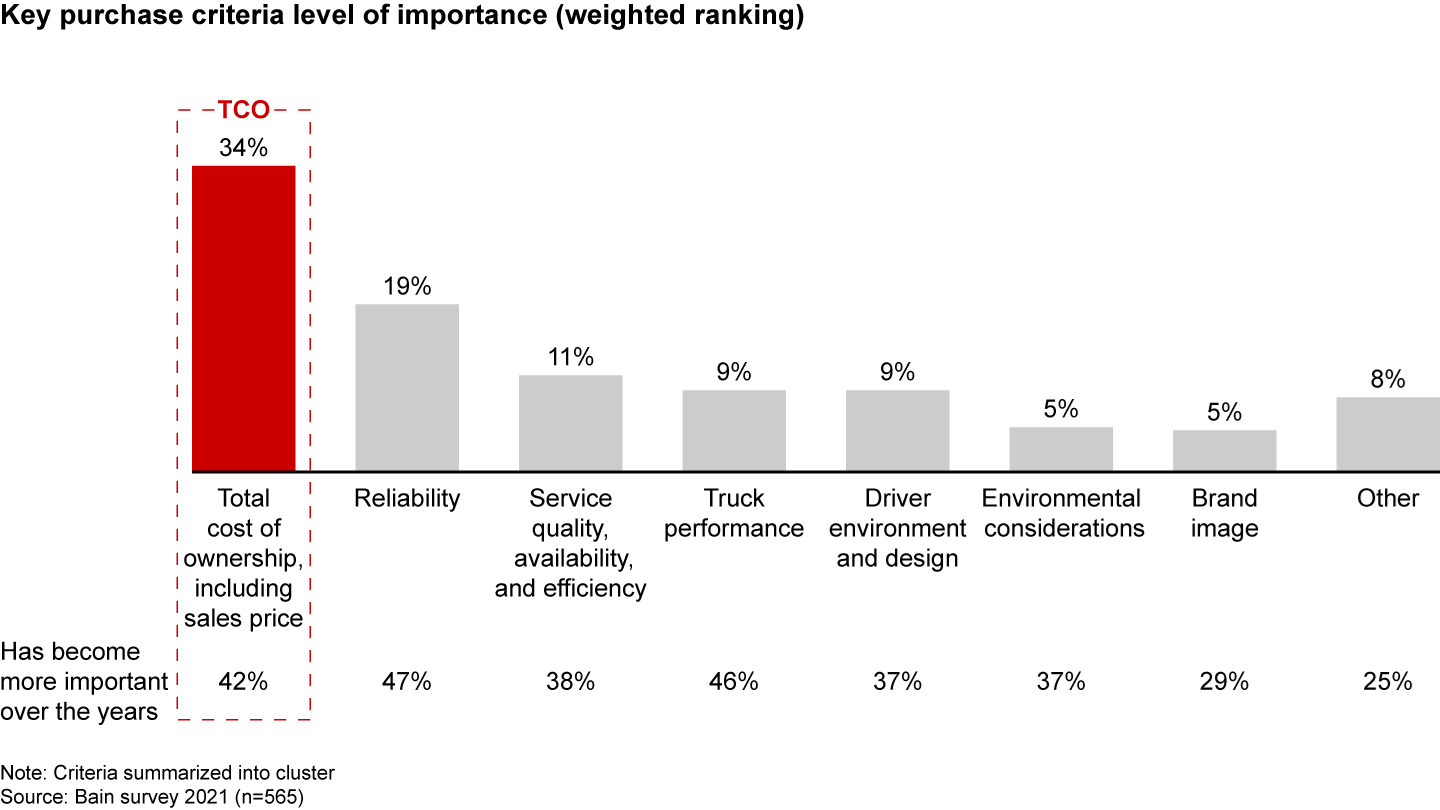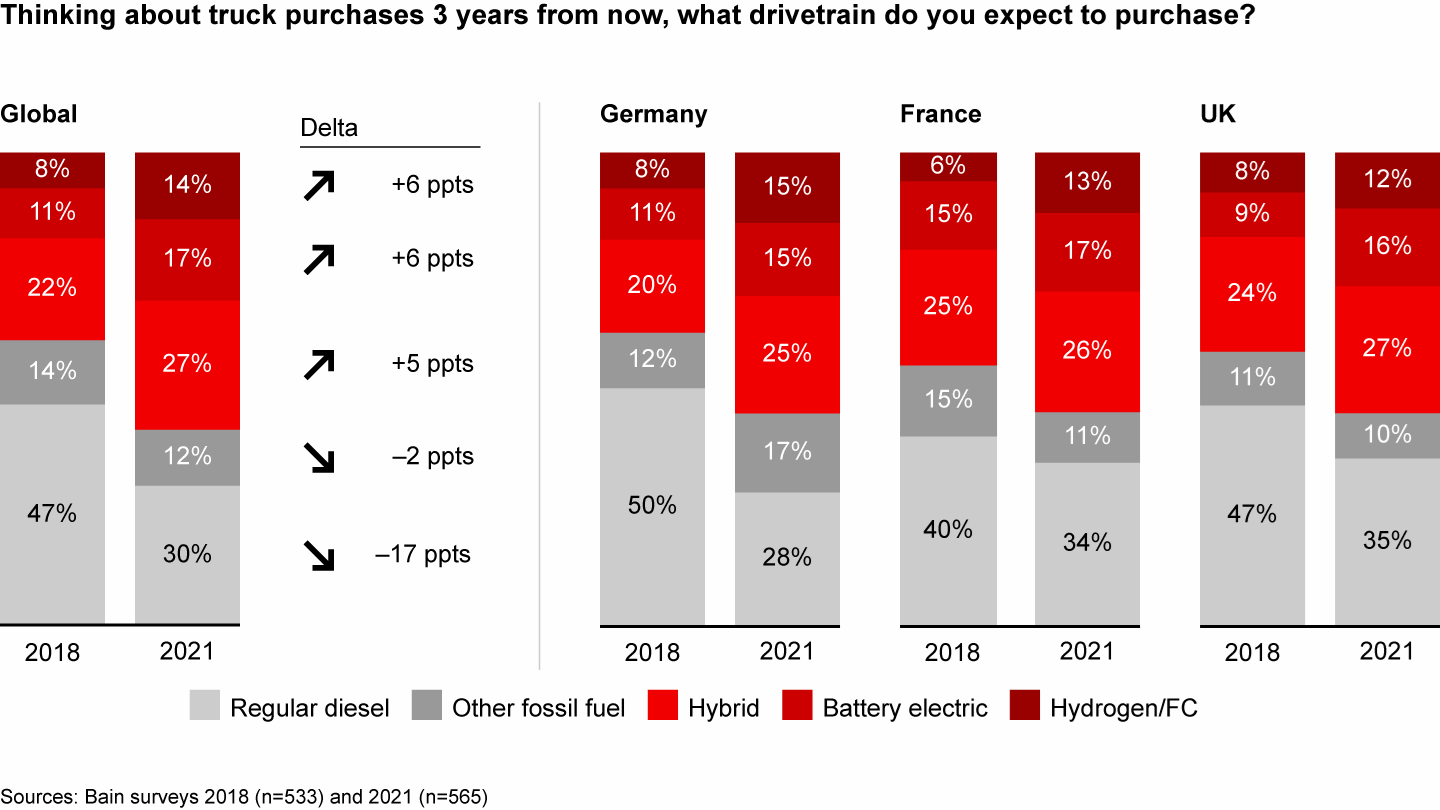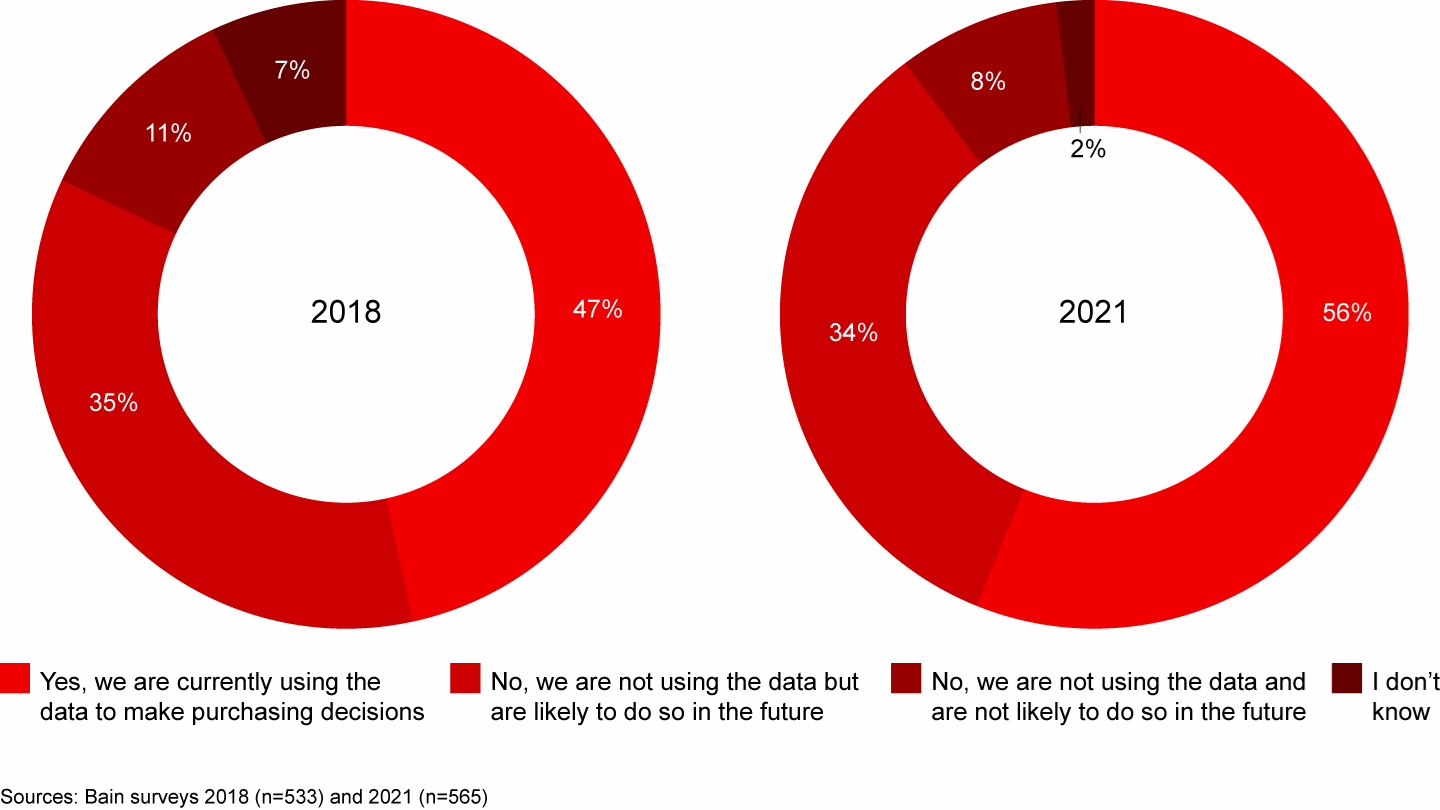Brief

At a Glance
- Net Promotor Score℠ (NPS®) improved across all brands, with owners of larger fleets generally indicating greater loyalty than owners of fleets with fewer than 10 vehicles.
- Buyers of heavy trucks in Europe remain focused on total cost of ownership (TCO) as the most important criterion when purchasing diesel or fossil fuel vehicles. However, buyers of alternative drivetrains focus more on range, performance, and efficiency. Both groups increasingly prioritize reliability as a key purchase criterion.
- Interest in alternative drivetrains has risen significantly since our previous study in 2018: Now, more than 60% of all buyers indicate an intent to add trucks with alternative drivetrains to their fleets with their next purchase.
- Manufacturers that want to differentiate their alternative drivetrain offerings can take advantage of a strong interest in new ownership models, such as long-term rentals or subscription services. Such models generally get high interest, but buyers of alternative drivetrains are especially eager to use such models, primarily to reduce their risk exposure.
- Buyers now expect a fully omnichannel experience for all stages of the purchasing journey, from initial research and truck configuration to vehicle sales and aftersales service booking.
- With more than half of survey respondents now using data from their connected fleets to make purchasing decisions and almost three-quarters viewing robust aftersales services as an important factor in customer loyalty, manufacturers should also prioritize the strength of such service offerings.
In a year of global upheaval, Europe’s truck buyers continue to prioritize total cost of ownership (TCO) as the top purchasing criterion. Despite the continuation of this long-standing trend, previously identified changes in the ways that customers select and purchase commercial vehicles are now accelerating rapidly. Amid the pandemic, supply chain constraints, and continued technological disruptions, customer preferences provide clear guidance for manufacturers that want to pull ahead of the competition.
Bain & Company’s most recent survey of Europe’s commercial truck market indicates that when it comes to customer loyalty, as measured by the Net Promoter ScoreSM (NPS®), manufacturers are reaping the benefits of previous efforts to improve TCO and reliability and to meet customer demand for service options. Surveyed in Q2 2021, more than 550 commercial fleet owners and operators across Europe’s four largest markets (Germany, the UK, France, and Spain) report an improvement in NPS over time, with an average of 7 percentage points gained across all brands. Overall, total NPS in 2021 is now at 34%, up from 27% in our 2018 survey. NPS correlates with fleet size: The bigger the fleet, the higher the NPS. Although this correlation does not necessarily reflect customer segment profitability, it indicates that truck manufacturers have continued to focus on large customers. The significant shifts that we see for individual operators, countries, and customer segments are a call for action. To continue this winning trend, manufacturers should focus on all TCO dimensions and on reliability—top reasons that buyers reported for recommending and choosing a brand.
Our study finds that TCO—a combination of various factors, including purchase price, residual value, and aftersales costs—is still the top factor in the purchase of diesel trucks (see Figure 1). But buyers’ interest in alternative drivetrains continues to gain traction, accompanied by a desire for new ownership models that provide a buffer against potential uncertainties. Also, for manufacturers that want to improve customer engagement, fully omnichannel options for researching, selecting, and purchasing vehicles—combined with robust aftersales services—offer an important advantage.
Total cost of ownership is the top purchase criterion, well above reliability and performance


For now, the focus on TCO still dominates European fleets. Not only do 34% of buyers rank TCO as their top purchasing factor, but 42% of survey respondents say it is more important than ever. Five years ago, especially buyers and owners of larger fleets were TCO savvy. Now, owners and operators in every segment increasingly use data from their connected fleets to make purchasing decisions based on their actual TCO data, contributing to the increasing importance of that criterion.
With expanded access to detailed TCO information thanks to new technologies, owners and operators in every segment increasingly use data from their connected fleets to make well-informed purchasing decisions based on actual TCO performance.
An even larger percentage—47%—of truck buyers note the increasing importance of reliability. This interest is not new. But recent increases in supply chain complexities, coupled with growing time pressures and low failure tolerance in logistic chains, make this factor an increasingly important consideration—good news for makers of reliable premium trucks.
Reliability is also the top measure of satisfaction with aftersales services. Truck buyers across all segments measure it as the most important factor when thinking about such services, followed closely by speed of service (97%) and cost of spare parts (97%) and service hours (91%). Interestingly, buyers do not seem particularly concerned with service network density. A focus on increasing reliability across all types of trucks at all stages of purchase and ownership offers manufacturers a way to stand out from the crowd.
Reliability is growing in importance as a key purchase criterion—both with regard to reliability of the truck itself, across all drivetrains, and in aftersales services. This increasing focus on reliability across all stages of purchase and ownership offers manufacturers a way to stand out from the crowd.
Another smart move for manufacturers: forging ahead with alternative drivetrain offerings. Our previous studies had already indicated a strong interest in battery-electric, hydrogen/fuel cell, and hybrid alternatives, and that interest has only grown. In 2018, about 40% of survey respondents said they might want to include an electric or hybrid drivetrain in their next round of purchases. Just three years later, that number has jumped to around 60%, with respondents expecting their fleets to feature a near 50/50 split of diesel/fossil fuel and alternative drivetrains by 2025. By 2030, buyers expect alternatives to edge out diesel and fossil fuel trucks as that split shifts to 40/60. Accordingly, respondents reported a significant drop in interest in new diesel trucks, from 47% in 2018 to just 30% in 2021.
As a result, the time for planning is over; manufacturers that are ready to meet the demand for alternative drivetrains are poised to win more customers than manufacturers with limited offerings—if they succeed in mobilizing their salesforce and advertising their new truck offerings.
Buyers are somewhat nervous about this evolution, however, even as they embrace new drivetrain options. A focus on range (100%), performance (56%), fuel efficiency (54%), reliability (53%), and purchase price (53%) bump TCO from its top spot in fleet owners’ list of purchase priorities for alternative vehicles.
Also, the current interest in hybrid vehicles, still visible in some buyers, likely reflects this uncertainty about leaving fossil fuels behind. But make no mistake: The long-term future of commercial fleets lies in fully electric vehicles—either battery-electric or hydrogen, depending on truck application. To help fleet owners and operators navigate the transition to electric, manufacturers can invest in educating their salesforces and buyers about new drivetrains, growing the infrastructure, and providing technological support for increased range and charging options.
When it comes to hurdles to attracting customers to alternative drivetrain offerings, expense of the truck takes the lead. To counter this concern, manufacturers can consider implementing new ownership options, such as rentals, subscriptions, or pay-per-use. Forty-two percent of respondents indicated that such options would make them more willing to accept an alternative drivetrain.
How to educate interested fleet owners and operators about such offerings? Manufacturers can meet customers’ needs for anywhere, anytime information by offering a seamless omnichannel experience that spans the ownership lifecycle. Integrated digital and personal touchpoints that explain the benefits and new challenges of alternative drivetrains will engage truck buyers at every stage while providing an ideal way to communicate product advances, new offerings, and aftersales services.
Increase interest in alternatives with new ownership options
With about 60% of buyers expressing interest in adding alternative drivetrains to their next round of purchases, urgency is growing for Europe’s commercial truck manufacturers to make such offerings available. The growth in this demand is significant and similar across all regions, fleet sizes, and application segments (see Figure 2).
Interest in alternative drivetrains increased 7 percentage points from 2018


Whereas our 2018 survey showed approximately 60% of buyers expecting to purchase diesel and fossil fuel drivetrains three years into the future, only about 40% expect to do so now. No segment expected to maintain a majority-diesel fleet by 2030, and only haulage buyers expected to maintain a 50/50 split.
Buyers who are planning their next electric truck purchase consider range to be the most important buying criterion. Eighty-two percent of buyers also flag range constraints as a top purchasing hurdle. However, new initiatives—such as the recently announced EU Fit for 55 legislative proposal package—will affect the EU Emissions Trading Scheme for transport by aiming to increase access to charging stations. In addition, we expect battery technology to continue improving battery capacity and thus the range of commercial vehicles. Charging speeds will increase, thus reducing time lost to charging. Fuel cell electric trucks could claim their stake in certain applications, such as long-haul fleets or other applications for which longer charging breaks might be difficult.
Purchase price and reliability are other key considerations for truck buyers. Uncertainty about new technologies is giving fleet owners and operators some pause. Manufacturers that want to meet demand while soothing these jitters can offer new forms of ownership, such as rentals, subscriptions, or pay-per-use options. More than 40% of respondents across all surveyed segments, fleet sizes, and countries say that their acceptance of alternatives would increase under such models. Clearly, manufacturers should act quickly to meet the demand for alternative drivetrains. Those that want to differentiate themselves to customers can promote alternative buying options as well.
Slightly more than 30% of the fleet owners and operators we surveyed expressed strong interest in subscription or usage-based ownership models. About 20% say they would switch the majority of their fleets, and another 10% say they would switch all their trucks to alternative drivetrains if such options were available. Owners of small fleets (those with 1 to 10 vehicles) expressed the most interest in transitioning their entire fleet, with the distribution and haulage segments expressing the greatest overall interest. We expect this trend to accelerate with the growth of demand for more expensive battery-electric trucks, as owners look for ways to offset high investment costs.
With the strength of this interest, savvy manufacturers have an opportunity to shape attractive offerings. A focus on new models of ownership with more flexibility and less risk for the customer can make the switch to new drivetrains more palatable by shifting cost burden from one large down payment to monthly installments and offsetting uncertain resale values. We recommend that manufacturers work diligently to make options such as long-term rentals a valid business model.
Savvy manufacturers have an opportunity to shape attractive offerings. A focus on new models of ownership with more flexibility and less risk for the customer can make the switch to new drivetrains more palatable.
Satisfy increasing demand for omnichannel sales
Our previous survey showed strong interest in omnichannel options for researching, selecting and configuring trucks as well as for booking aftersales services. The trend toward online options further increased with the advent of the COVID-19 pandemic.
Consequently, it is fair to say that truck sales are now already fully omnichannel. Nearly three-quarters of customers now conduct their initial research and truck configuration online and use digital or a mix of digital and dealer touchpoints to arrange financing and aftersales services. About 70% of customers already consider online purchasing to be a viable option, although about 40% still want an available dealer touchpoint. Interest in digital-only sales, while still in the minority, rose about 5% from 2018. By 2025, about a quarter of survey respondents expect to use primarily digital or omnichannel options for every step of the purchase process. This is especially true for larger fleets that tend to buy the same truck in the same configuration several times a year—and so don’t need much personal advice for these repeat purchases.
Manufacturers that want to take advantage of the interest in omnichannel sales would do well to pair a robust digital experience with a real-live representative who can offer personalized services regarding configuration options, service contracts, and financing. This approach provides a way to reduce costs related to expensive brick-and-mortar sales networks while meeting customer appetite for advanced digital functions such as online ordering, personalized offers, and product and service education.
Win hearts and minds with robust aftersales services
Aftersales services should also remain a focal point for manufacturers. A majority of surveyed buyers—about 75%—noted the importance of such services, and nearly half of large-fleet owners rate aftersales as very important. When it comes to these services, 100% of respondents value reliability of service, 97% value speed of service and cost of spare parts, and 85% consider the availability of replacement vehicles.
Here, flexibility is less important than the ability to plan for expenses. More than 80% of buyers are more interested in service contracts at a fixed monthly price than in flexible contracts.
Furthermore, as noted in our previous survey, fleet managers and owners are increasingly sophisticated in the use of fleet data. More than 55% of respondents now use data from their connected fleet to make purchase decisions, an increase of 10 percentage points over 2018 (see Figure 3). Providing robust aftersales service options that keep those fleets running smoothly can help manufacturers maintain customer goodwill.
More than half of buyers currently use connected fleet data in purchasing decisions


The paradigm shifts identified in our 2018 survey—toward alternative drivetrains, new ownership models, and omnichannel experiences—are rapidly accelerating. Manufacturers that want to stay ahead of the competition must now move from developing concepts or planning such measures to implementing and promoting them. We suggest the following steps as top priorities:
- Expand alternative drivetrain options—fast. The move toward electric vehicles is happening faster than anticipated. We expect to see the balance to shift from diesel and fossil fuels to electric within the next five years. Manufacturers can prepare for this shift by forging ahead on alternative options. Educating their salesforces and customers about improvements in range and reliability is especially important to encourage nervous buyers—as is reviewing opportunities to provide superior charging solutions.
- Focus on reliability. Buyers are keen on reliability across every segment and aspect of ownership. Manufacturers that can prove the reliability of both their vehicles and their service offerings can win the trust and loyalty of fleet owners and managers.
- Strengthen omnichannel sales. With customers showing a growing preference for online options during every stage of the buying journey, from research to service scheduling, manufacturers can streamline their go-to-market approach while meeting customer demand.
- Develop multiple ownership models. Manufacturers across Europe can ease the transition to alternative drivetrains by offering a variety of ownership models, including rent-to-buy and subscription options.
- Build in robust service contracts. Fast, reliable aftersales services are key to maintaining customer satisfaction and encouraging return business.
By taking these steps, European commercial truck manufacturers can continue building on already positive NPS trends, increase customer loyalty and engagement, and prepare themselves for success over the next decade.
The authors are grateful for the support Michael Hoening and Ingo Stein provided to this study.